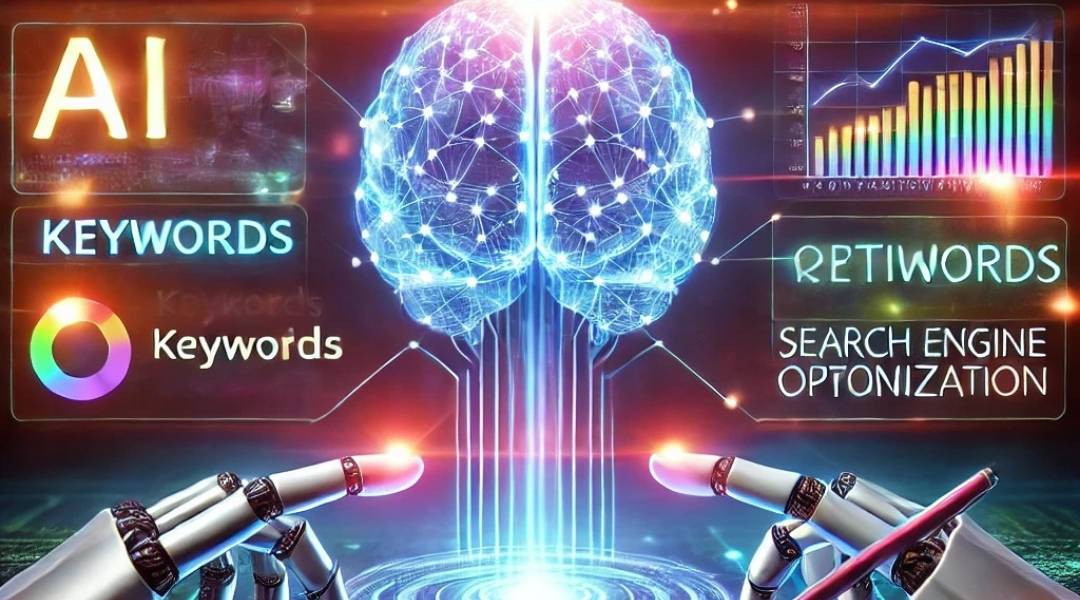Using AI for on-page SEO and understanding SEO AI can seriously up your digital marketing game. You start by leveraging artificial intelligence to pinpoint the perfect keywords, then craft content that hooks readers from the get-go.
You’ve got the data; now it’s time to make sense of it. Understanding user behavior on your site is the ticket to revamping their journey. Meta tags and images? Forget about getting lost in the crowd—AI is on the job, pushing your website to the top of search results. Then there’s tweaking your website structure and making sure pages load rapidly. Backed by clever computer code every step of the way.
Don’t forget about keeping an eye on what competitors are doing or preparing your site for voice searches using AI as well. As AI tools expertly tailor the user experience, we’ll refocus on optimizing keywords with precision, always mindful that the people behind the scenes are what make these automated systems truly effective.
Leveraging AI for Keyword Optimization
Starting off, let’s talk about using AI for keyword optimization. It really changes the game. You see, AI tools can analyze heaps of data in no time.
This includes search patterns and trending topics across various platforms like social media and forums. By tapping into natural language processing, these smart technologies get what people are actually looking for. They pinpoint keywords that match user intent closely.
Think about it; this approach moves you beyond guesswork to making informed choices on which terms will drive traffic your way. But I’ve learned over the years that blending AI insights with human expertise is key. While AI gives us a powerful starting point, understanding subtleties and creating connection-driven content still needs a human touch.
So you’ve got your killer keywords from an SEO AI. Pair those findings with creative storytelling and strategic thinking. That ensures not just visibility but real engagement, too.
Creating Compelling Content with AI Tools
Before we dive into the world of AI-assisted content creation, let’s pause for a moment and think about what this means. You’re looking at unlocking new levels of efficiency and creativity in your writing process.
- Boosting Content Discovery: AI tools come with the superpower to sift through data piles faster than you can say “SE.”. They offer up gems—facts, stats, trends—that would take us ages to find manually. This is gold when you want your blog to shine with authority and intrigue readers.
- Firing Up Creativity: Have you ever stared blankly at your screen? We’ve all been there. But here’s a cool thing: AI can throw out ideas that spark our own creativity. It’s like having an ever-ready brainstorming buddy who never runs out of suggestions or coffee, even suggesting twists I wouldn’t have thought of!
- Polishing Until it Shines: Beyond just catching typos (which honestly feels magical), these smart assistants can punch up our style without killing vibes. With their feedback loop on grammar, tone, and even readability, our posts get snazzier yet stay true gold. Who knew robots could make us look so good?
By blending these strategic moves seamlessly into our workflow using tech smarts from those handy digital aides, each post leaps closer towards captivating reads stuffed richly in quality substance, meaning connection. It isn’t Now about in many ways!
AI-Driven Analysis of User Experience
Let’s dive straight into how AI pushes the user experience on your website a notch higher. First off, AI helps you personalize content like never before. Picture this: it gathers data on how individuals interact with your site and uses that to make spot-on predictions about what they’ll want next.
That’s giving people exactly what they’re looking for without them having to ask. Then there’s readability and engagement—big words; I know, I’m saying that AI tools take a hard look at your text and suggest tweaks so anyone can get it, boosting the connection with readers.
Adaptive content—that’s just a fancy way of saying your website talks to visitors like old friends, no matter where or when they’re browsing, from their mood right down to the device they’re using. Pulling all these strings together doesn’t just make people happy; it indirectly but surely boosts where you stand in search results because, let me tell you, Google notices when users love your site. And while we’re not talking shortcuts here—putting real thought behind every word still counts—incorporating AI sure makes climbing up those SERPs feel less like guesswork and more strategic.
Optimizing Meta Tags Using Artificial Intelligence
Before jumping into the nitty-gritty of using artificial intelligence to optimize your meta tags, let’s set the stage. We’re exploring practical ways AI can not just simplify but also elevate how we handle SEO tasks on our web pages. It’s no secret that putting in effort here pays off by making content more discoverable and appealing to search engines.
- Choosing Your AI Tool: Picking out an AI tool is like selecting a new member for your team—it needs to fit right in. Look for one with rave reviews and features tailored to SEO success. Make sure it feels easy enough to use without needing a PhD in computer science. Watch tutorials, like those quick one-minute guides available online, showing you exactly what steps are necessary.
- Integrating With Strategy: Your next task? Blend this shiny new tool seamlessly into your broader SEO strategy without causing disruption or chaos—easier said than done sometimes! Prioritize crafting meta descriptions so they truly reflect each page’s essence while also naturally incorporating key phrases for which you want high rankings. Remember, too, that keeping tabs on performance gives insights, allowing further refinement.
- Avoiding Common Pitfalls: Last up is dodging those sneaky pitfalls waiting around corners—to start with, uniqueness counts way more than some realize at first glance, ensuring accurate representations prevent misleading visitors (no happy camper there if led astray). Dealing with technical hiccups swiftly prevents them from ballooning into major headaches later down the road—a pro tip!
Improving Site Structure Through AI Insights
Improving your site’s structure with AI insights isn’t just nice—it’s essential if you want to stay ahead. These tips are all about making your website more accessible, not only for users but for search engines, too.
- Streamline Your Site Hierarchy: Think of your website as a library where everything needs its place. Start sorting; create main categories that make sense to users and search engines alike. For instance, dividing a cooking blog into “Recipes,” “Cooking Tips,” and “Equipment Reviews” helps everyone find their way around easier. This clear organization assists AI tools in understanding what each section is about.
- Clean Up Your URLs: A clean URL is like giving someone exact directions to where they want to go without any detours. Keep them readable and relevant — ‘/fitness/yoga-for-beginners’ tells you exactly what’s on the page, while something like ‘/page1234’ leaves us guessing. Just imagine typing those messy links by hand; nobody wants that; crystal-clear URLs help both humans and algorithms understand your content better.
- Prioritize Responsive Design & Loading Speed: You’ve heard this before, but let me say it again: websites need to work smoothly across devices. Speed counts, too, since no one enjoys waiting for slow pages. PageSpeed Insights points out potential fixes. Getting these basics right takes care of technical SEO aspects vital for solid performance in an AI-driven web era. It shows Google (and visitors)that you’re serious about providing top-notch experiences.
Incorporating Voice Search Optimization and AI
So, let’s talk about how incorporating voice search optimization and AI into your strategy can really shake things up. Have you ever caught yourself talking to your phone or smart speaker to look something up? This is where the magic of optimizing for voice search comes in.
By using AI tools, you start hitting those keywords and phrases people actually use when they speak—no more stiff, formal searches but rather conversational phrases that real humans use. And here’s a nugget of wisdom: individuals are always asking questions out loud on their devices. Why not be the one who answers them?
Use AI to spot these common questions and sprinkle them throughout your content like fairy dust. We aren’t just throwing spaghetti at the wall to see what sticks; we’re crafting with purpose here. Grouping our keywords based on user intent discovered through AI’s deep-dive capabilities ensures our content hits the right target every time.
But wait, there’s more! Don’t just throw all this great info together. Let AI outline it first so everything flows smoothly.
They even help keep those titles catchy and meta descriptions crisp to boost that sweet on-page SEO appeal. Remember, combining good old research from trusted platforms with shiny new insights from AR lets us cover all bases without missing a beat.
Navigating AI for on-page SEO can feel a bit like trying to order coffee at that fancy new café downtown. You know, the one where they use words you’ve never heard before. But once you get it right, magic happens.
Start with understanding your audience and content goals. Use AI to research keywords, but don’t forget the human touch when crafting engaging content. Monitor performance with smart tools but always question if there’s a better way to connect with visitors.









